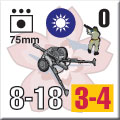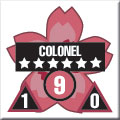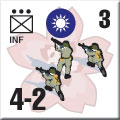Changsha Operation
Scenario Preview, Part One
by Mike Bennighof, Ph.D.
January 2022
For the first time ever, we’re taking the Panzer Grenadier series to the War of Resistance Against Japanese Aggression. Japan launched a full-scale invasion of China in 1937, after years of prior incidents, and the war continued for eight years before Japan’s defeat.
 At Changsha (the second or third battle, depending on who’s counting), the Chinese won one of their rare battlefield victories against the Japanese. The Japanese advanced on the city in December 1941 to distract the Chinese from the attack on Hong Kong. They captured Changsha after bitter fighting, but the Chinese moved to encircle them and the Japanese 11th Army retreated. At Changsha (the second or third battle, depending on who’s counting), the Chinese won one of their rare battlefield victories against the Japanese. The Japanese advanced on the city in December 1941 to distract the Chinese from the attack on Hong Kong. They captured Changsha after bitter fighting, but the Chinese moved to encircle them and the Japanese 11th Army retreated.
Panzer Grenadier: Changsha Operation is a special expansion set exclusively for our Gold Club. It’s not for sale, and won’t be offered to anyone else. It’s a download, with 88 new Panzer Grenadier pieces and eight new scenarios. You’ll have to assemble the pieces, and you’ll need Korean War: Pusan Perimeter and Korean War: Counter Attack for the maps.
This is a different sort of Panzer Grenadier game. Neither side has any tanks, or motor vehicles of any kind. It’s a war fought by infantry with limited support weapons. The Japanese have some artillery, the Chinese next to none (so little that Chinese divisions had no artillery units of their own, even nominally, relying on the scant number of army-level battalions for what little support they did receive).
It's an infantry game, one that’s going to be resolved by close assaults and rifle fire, with machine-gun platoons often the heaviest weapons on the board. The scenarios play more like those from our Infantry Attacks series than typical Panzer Grenadier. So let’s have a look at the first chapter, five scenarios from the Japanese drive on Changsha.
Scenario One
Upper Shachiang Crossing
24 December 1941
 The Japanese offensive at Changsha began with a southward advance by the 11th Army against the opposing Chinese 20th Army of the Yang Sen Group. While the Chinese IX War Zone had alerted its troops to expect a Japanese offensive, the Chinese infantrymen still could not match the firepower the Japanese could bring to bear. The Japanese offensive at Changsha began with a southward advance by the 11th Army against the opposing Chinese 20th Army of the Yang Sen Group. While the Chinese IX War Zone had alerted its troops to expect a Japanese offensive, the Chinese infantrymen still could not match the firepower the Japanese could bring to bear.
Conclusion
Despite plenty of warning, the Chinese seemed unprepared for the Japanese assault and fell back from the river line in some disarray. The Japanese marched after them, believing this yet another instance of their Chinese enemies melting away before superior firepower. But Pi Yueh, commander of the IX War Zone (army group), had prepared a series of lines to allow his troops to fall back steadily and maintain their resistance.
Notes
The Chinese are holding a river line against the Japanese, who need to force their crossing directly in the face of the Chinese defenders. The Japanese have some artillery backing, both on the board and off it, while the Chinese have a lot of guys with bayonets. They’ll need to mass them where they can to put the hurt on the Japanese.
Scenario Two
Night Crossing
26 December 1941
 The Japanese 3rd Infantry Division’s commander, Fusataro Teshima, had been slow assembling his formation for the offensive, and on the 24th 11th Army commander Korechika Anami fired him. When the division reached the swollen river Ku Shui on the evening of 26 December it seemed to form an impassable barrier. But the new division commander, Tagaji Takahashi, understood that he had not been appointed in order to be balked by mere water. Despite the darkness and the flood-stage river, he ordered an immediate crossing. The Japanese 3rd Infantry Division’s commander, Fusataro Teshima, had been slow assembling his formation for the offensive, and on the 24th 11th Army commander Korechika Anami fired him. When the division reached the swollen river Ku Shui on the evening of 26 December it seemed to form an impassable barrier. But the new division commander, Tagaji Takahashi, understood that he had not been appointed in order to be balked by mere water. Despite the darkness and the flood-stage river, he ordered an immediate crossing.
Conclusion
Shocked by the impossible river crossing, the Chinese defenders fell back after offering brief resistance along the riverbank. Japanese battlefield successes in China relied on relentless aggression far more than firepower, and Takahashi pushed his new command to achieve the impossible. Yet the Chinese still had a say in how this battle would play out.
Notes
It’s another river crossing, this time along a broader front and at night. The Chinese are outnumbered, and at a severe morale disadvantage against one of the best divisions in the Imperial Japanese Army. But the Japanese have to achieve a great deal to win, so all the Chinese need to do is to get in their way – and that’s still a tall order.
Scenario Three
To the Water’s Edge
27 December 1941
 Stunned by the daring Japanese night-time crossing of the raging Ku Shui, the Chinese New 20th Infantry Division rallied surprisingly quickly and organized a counter-attack. With some luck, the Chinese might be able to throw the Japanese back across the river and restore what should have been a very strong defensive position. Takahashi’s new command suddenly faced the rare occurrence of a Chinese division on the attack. Stunned by the daring Japanese night-time crossing of the raging Ku Shui, the Chinese New 20th Infantry Division rallied surprisingly quickly and organized a counter-attack. With some luck, the Chinese might be able to throw the Japanese back across the river and restore what should have been a very strong defensive position. Takahashi’s new command suddenly faced the rare occurrence of a Chinese division on the attack.
Conclusion
The Chinese struck with as much force as they could muster, and briefly forced the Japanese back toward the river. But swift counter-attacks soon restored the Japanese position and routed the attackers. With so little in the way of support weapons, the best opportunities for the Chinese to attack came when they caught the Japanese in a vulnerable position such as this one. But the crack 3rd Division was only briefly slowed in its advance.
Notes
The Japanese have just gotten over the river when the Chinese come back to throw them in. It’s a great many Chinese, so despite their poor morale, they do have a shot at doing just that. And the Chinese artillery makes a rare appearance, not that it’s enough to make much of a dent in the Japanese defenses.
Scenario Four
Changsha Castle
1 January 1942
 Japanese aerial reconnaissance indicated that the Chinese held the city of Changsha only lightly. At 11th Army headquarters, Gen. Korechika Anami ordered all three divisions making up his spearhead to press hard for the city before the Chinese could reinforce their defenses. With their backs to the broad Xiang River, the three depleted divisions of the Chinese 10th Army had dug in and prepared to defend every block of the city. Japanese aerial reconnaissance indicated that the Chinese held the city of Changsha only lightly. At 11th Army headquarters, Gen. Korechika Anami ordered all three divisions making up his spearhead to press hard for the city before the Chinese could reinforce their defenses. With their backs to the broad Xiang River, the three depleted divisions of the Chinese 10th Army had dug in and prepared to defend every block of the city.
Conclusion
The Chinese fought desperately to hold Changsha, but the Japanese advanced relentlessly. A Chinese counter-attack ejected the invaders from their foothold, forcing them to withdraw. They would return the next day, attacking with an additional division plus air support. By the evening of 4 January, the Japanese had secured Changsha, but the Chinese were not ready to concede.
Notes
This time the Japanese have to attack a small city and drive out the Chinese, who aren’t ready to give it up. That means the Japanese will have to get close and take it hex by hex, something they can accomplish with their sky-high morale. On the other hand, the Japanese heavy weapons (such as they are) can’t make nearly as much impact here.
Scenario Five
Meeting by Night
3 January 1942
 North-east of Changsha, the Japanese 11th Army ordered its 40th Infantry Division to move to cover the rear and left flank of the divisions attacking Changsha. The Japanese division had just begun to assemble for the night march when a Chinese division carrying out the very attack that 11th Army commander Korechika Anami feared plowed into its outer pickets. North-east of Changsha, the Japanese 11th Army ordered its 40th Infantry Division to move to cover the rear and left flank of the divisions attacking Changsha. The Japanese division had just begun to assemble for the night march when a Chinese division carrying out the very attack that 11th Army commander Korechika Anami feared plowed into its outer pickets.
Conclusion
The Chinese kept up their attacks through the night and the next day, keeping the 40th Infantry Division fully engaged with the Chinese 95th Infantry Division and unable to either joint he assault on Changsha or reach its flank-guard positions. Even as the last Chinese defenders of Changsha were rooted out, the Japanese 11th Army command issued orders to withdraw from the just-conquered city before the Chinese could encircle them there.
Notes
It’s a night attack by the Chinese against a Japanese division that’s not expecting such initiative. The Chinese will want to inflict as many casualties as possible and disrupt the Japanese, and they have the force that can do that.
And that’s Chapter One. Next, we’ll look at Chapter Two.
Want if for yourself? Click right here to join the Gold Club.
Sign up for our newsletter right here. Your info will never be sold or transferred; we'll just use it to update you on new games and new offers.
Mike Bennighof is president of Avalanche Press and holds a doctorate in history from Emory University. A Fulbright Scholar and NASA Journalist in Space finalist, he has published a great many books, games and articles on historical subjects; people are saying that some of them are actually good.
He lives in Birmingham, Alabama with his wife, three children, and his Iron Dog, Leopold.
Want to keep Daily Content free of third-party ads? You can send us some love (and cash) through this link right here.
|
